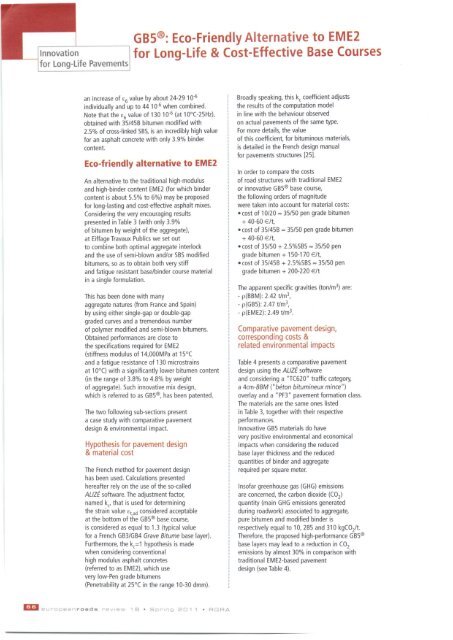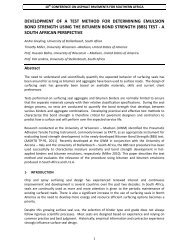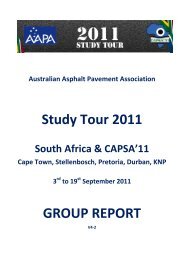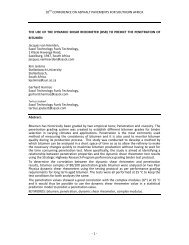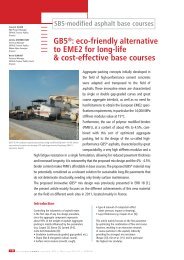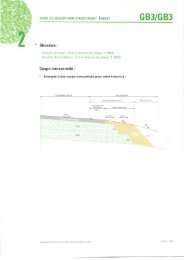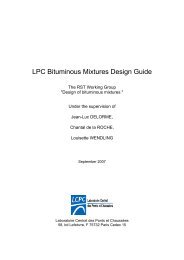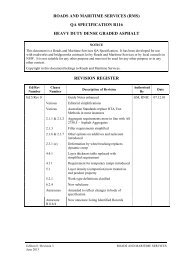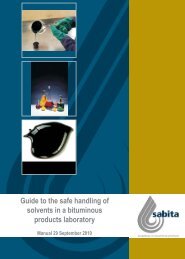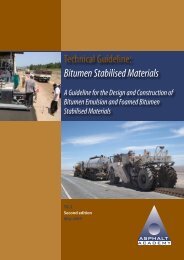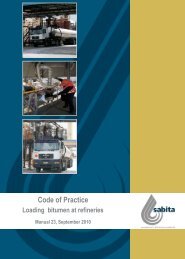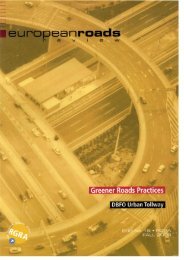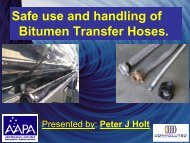Warm Mix Asphalt - Aapaq.org
Warm Mix Asphalt - Aapaq.org
Warm Mix Asphalt - Aapaq.org
You also want an ePaper? Increase the reach of your titles
YUMPU automatically turns print PDFs into web optimized ePapers that Google loves.
-Innovationfor long-life PavementsGB5®: Eco-Friendly Alternative to EME2for Long-life & Cost-Effective Base Coursesan increase of E6 value by about 24-29 10- 6individually and up to 44 10- 6 when combined.Note that the E6 value of 130 10- 6 (at 10°C-25Hz),obtained with 35/45B bitumen modified with2.5% of cross-linked 5B5, is an incredibly high valuefor an asphalt concrete with only 3.9% bindercontent.Eco-friendly alternative to EME2An alternative to the traditional high-modulusand high-binder content EME2 (for which bindercontent is about 5.5% to 6%) may be proposedfor long-lasting and cost-effective asphalt mixes.Considering the very encouraging resultspresented in Table 3 (with only 3.9%of bitumen by weight of the aggregate),at Eiffage Travaux Publics we set outto combine both optimal aggregate interlockand the use of semi-blown and/or 5B5 modifiedbitumens, so as to obtain both very stiffand fatigue resistant base/binder course materialin a single formulation .This has been done with manyaggregate natures (from France and 5pain)by using either single-gap or double-gapgraded curves and a tremendous numberof polymer modified and semi-blown bitumens.Obtained performances are close tothe specifications required for EME2(stiffness modulus of 14,000MPa at 15°Cand a fatigue resistance of 130 microstrainsat 10°C) with a significantly lower bitumen content(in the range of 3.8% to 4.8% by weightof aggregate). 5uch innovative mix design,which is referred to as GB5®, has been patented.The two following sub-sections presenta case study with comparative pavementdesign & environmental impact.Hypothesis for pavement design& material costThe French method for pavement designhas been used. Calculations presentedhereafter rely on the use of the so-calledALIZE software. The adjustment factor,named kc' that is used for determiningthe strain value Et,ad considered acceptableat the bottom of the GB5® base course,is considered as equal to 1 .3 (typical valuefor a French GB3/GB4 Grave Bitume base layer).Furthermore, the k c = 1 hypothesis is madewhen considering conventionalhigh modulus asphalt concretes(referred to as EME2), which usevery low-Pen grade bitumens(Penetrability at 25°C in the range 10-30 dmm).Broadly speaking, this kc coefficient adjuststhe results of the computation modelin line with the behaviour observedon actual pavements of the same type.For more details, the valueof this coefficient, for bituminous materials,is detailed in the French design manualfor pavements structures [25].In order to compare the costsof road structures with traditional EME2or innovative GB5® base course,the following orders of magnitudewere taken into account for material costs:• cost of 10/20 - 35/50 pen grade bitumen+ 40-60 € /t,• cost of 35/45B = 35/50 pen grade bitumen+ 40-60 € /t,• cost of 35/50 + 2.5%5B5 - 35/50 pengrade bitumen + 150-170 € /t,• cost of 35/45B + 2.5%5B5 - 35/50 pengrade bitumen + 200-220 €/tThe apparent specific gravities (ton/m 3 ) are:- p(BBM): 2.42 tlm 3 ,- p(GB5): 2.47 tlm 3 ,- p(EME2): 2.49 tlm 3 .Comparative pavement design,corresponding costs &related environmental impactsTable 4 presents a comparative pavementdesign using the ALIZE softwareand considering a "TC620" traffic category,a 4cm-BBM ("beton bitumineux mince")overlay and a "PF3" pavement formation class.The materials are the same ones listedin Table 3, together with their respectiveperformances.Innovative GB5 materials do havevery positive environmental and economicalimpacts when considering the reducedbase layer thickness and the reducedquantities of binder and aggregaterequired per square meter.Insofar greenhouse gas (GHG) emissionsare concerned, the carbon dioxide (C0 2)quantity (main GHG emissions generatedduring roadwork) associated to aggregate,pure bitumen and modified binder isrespectively equal to 10, 285 and 310 kgCO/t.Therefore, the proposed high-performance GB5®base layers may lead to a reduction in CO 2emissions by almost 30% in comparison withtraditional EME2-based pavementdesign (see Table 4).aD! europeanroads revew 1 B • Spring 2011 • RGRA


